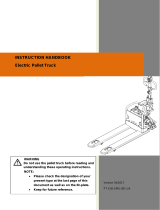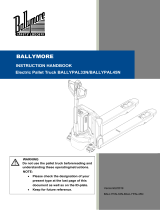Page is loading ...


I
IN
NT
TR
RO
OD
DU
UC
CT
TI
IO
ON
N
Welcome to use our Floor crane. WCF series of floor crane is designed with fixed legs with adjustable
length, WCE is designed with adjustable width straddle legs and WCR is designed with none leg with counter
balance weight. It is developed for used in workshop, maintenance and logistic area. Working in workshop,
you could use it to pick up and reposition of heave pieces of work, machine tools, chucks, steel bar/plate etc.
items be moved into and placed onto a bench or inside of a machine even it is flushed with the floor or the top
cover. It is designed with removable third booms, which could be replaced with some other special function of
tools, such as drum rotator, double/four hooks arm and so forth. Special tools are available upon request.
The compact designed of crane is ergonomically being used in the tightest of spaces. Full power design is friendly
for operator to use for lifting, extending and driving. The integreted hydraulic system provides safety velocity
fuse, adjustable flow control and compensated flow control valve, overlord relief valve and so forth. The driving
system provide all the safety features from a standard walkie trucks, such as speed control, emergency stop and
magnetic brake and so forth. Just a button, you can lift and move everything to everywhere you need.
NOTE: All of the information reported herein is based on data available at the moment of printing. We reserve the
right to modify its own products at any moment without notice and incurring in any sanction. So, it is suggested to
always verify possible updates.
C
CA
AU
UT
TI
IO
ON
N
1.1 Read and understand Operator’s Manual before using the truck.
1.2 Do not operate this truck unless you are trained and authorized.
1.3 Do not overload this truck. Check capacity plate for loading weight and lifting height
1.4 Operate truck only from designated operating load position. Never place any part of your body under the
truck or near moving parts. Do not ride or carry passengers.
1.5 Before leaving the truck, remember fully low down lifting mechanism, and set parking brake by making sure
handle is in vertical position and turn off power with switch key.
1.6 Travel slowly and with caution on slopes. Always travel with load end down grades.
1.7 The drive system of this crane could be only used for long distance when it is without load. It is not allow for
transporting with load. When it is with load the drive system only be used for changing direction and
moving of the crane when it is in smooth area & in safety condition. When moving the crane with load, the
boom should be fully retracted, otherwise any wrong operation may cause a series damage of equipment
and injured of the person.

B
BE
EF
FO
OR
RE
E
O
OP
PE
ER
RA
AT
TI
IO
ON
N
2.1 Make sure that the battery cable connector is fully engaged into the battery compartment of the truck.
2.2 Check if there is full of battery supply.
2.3 Check if the truck is working properly. Give special attention to horn, speed controller and steering system.
2.4 Observe the condition of the truck for any other malfunction or defect.
2.5 Before leaving the unit, stop the unit and turn off power.

O
OP
PE
ER
RA
AT
TI
IO
ON
N
3.1 TO RAISE AND LOWER There are two buttons located on the right side of the handle. One is for raising the
hook. The other one is for lowering the hook. Make sure that there is no one standing near the truck or the
load when raising or lowering.
3.2 TO TRAVEL The butterfly switch controls the direction and speed of the lift truck. Rotate the butterfly controls
located on the upper part of the handle. Rotate the butterfly control CW towards the forks, the truck towards
in the forks first direction. The speed of the truck is controlled by the degree of rotation in either direction.
3.3 TO BRAKE This truck is equipped with a brake that is applied between 10~15 degrees of the vertical position
and between 85~90 degrees of the lower position in the vertical operating of the handle. The brake can be
operated at any point in the lateral operating of the handle. When you release your hand from the handle, it
will resume the neutral position automatically, as the brake in work. Always make sure that the brake is in
work before operating the truck. When packed, always put the handle in the full vertical position with the
brake applied and forks lowered.
3.4 DIRECTIONAL REVERSING SAFETY BUTTON At the top of the handle, red reversing button that is
designed to protect the operator from injury. If the top of the handle comes in touch with the operator’s body
during operation, the truck will automatically reverse direction and travel away from the operator. Then
immediately release your hands off the butterfly control and put the handle up and brake on. The safety
reversing button is spring-loaded, so it automatically resumes its original position after being activated.
3.5 HORN A horn is located on the front side of the handle.
3.6 KEY LOCK Before operating the truck, turn on the electric power first. The key lock is located on the battery
pack cover.

T
TR
RO
OU
UB
BL
LE
E
S
SH
HO
OO
OT
TI
IN
NG
G
If the truck fails any of these tests, do not operate this truck until the problem is resolved
4.1 Read and understand Operator’s Manual before using the truck.
4.2 Make sure that the battery cable connector is fully engaged into the battery compartment of the truck.
4.3 Make sure there has not any leakage of oil from previous use.
4.4 Turn the key switch on and check the battery meter to ensure if there is full of battery supply.
4.5 Check that the raising and lowering of the forks are working properly. Give special attention to horn, speed
controller and steering system.
4.6 Check the service brake operation by raising the handle to the vertical position and lowering it to the lowered
position to see that it fully stops the truck in either position.
4.7 Observe the condition of the truck for any other malfunction or defect.
Problem Possible cause
NO LIFT
(motor does not run)
Faulty wiring from fuse to lift switch in handle.
Faulty lift switch
Faulty wiring from lift switch to pump contactor.
Faculty lift contactor
Faulty wiring from battery positive terminal to
pump contactor, or from pump contactor to pump
motor
Burned out brushes in pump motor
Defective control circuit fuse
NO LIFT
(Motor runs)
Low hydraulic pressure caused by:
- Pressure relief valve needs adjustment
- Pump check valve stuck open
- Faulty solenoid valve
Check oil level if forks do not rise fully
Check hydraulic pump operation
Defective control circuit fuse
FORKS WILL NOT LOWER
Faulty lowering switch on steering handle
Faulty wiring from lowering switch to solenoid
valve
Faulty solenoid coil on soft shift control valve
Faulty soft shift control valve
Faulty load lowering valve
Faulty velocity fuse
Defective control circuit fuse
NO ELECTRICAL POWER
No electrical power caused by:
- Key switch in “OFF” position

NO ELECTRICAL POWER
- Emergency disconnect button depressed
- Faulty SB connector (or unplugged)
- Loose battery connections
- Blown control or power fuse
Faulty wiring from fuse to travel control switch
Faulty travel control switch
Faulty wiring from travel control switch t direction
contactor
Faulty contactor
Check traction motor

B
BA
AT
TT
TE
ER
RY
Y
&
&
B
BA
AT
TT
TE
ER
RY
Y
C
CH
HA
AR
RG
GE
ER
R
The batteries and battery charger are packed inside the battery pack. Follow the operating procedures to charge
battery:
5.1 Turn switch key CCW to turn off the power supply.
5.2 Disconnect the battery cable connector from compartment of the truck and then fully engaged it to the
compartment of the battery charger.
5.3 Before connecting the battery charger to the local power supply, check and insure that the voltage of both is
the same.
5.4 Connect the AC extension cord from the charger into the outlet of local power supply. This will automatically
turn the charger on, and it will run at a rate commensurate with the requirements of the batteries. The charger
will automatically control the charging procedure and when the batteries are fully charged, the charger will
only supply enough current to maintain batteries charge.
5.5 When the charging cycle is completed, disconnect the AC plug from the truck outlet and the power supply.
5.6 Remove the battery connector from charger and fully engaged it to the drive plug.
M
MA
AI
IN
NT
TE
EN
NA
AN
NC
CE
E
6.1 Only trained and authorized personnel should be permitted to maintain, repair, and inspect the unit.
6.2 Keep usage area cry, clean, and well ventilated.
6.3 To avoid fire hazards, have fire protection equipment present at all times during any maintenance or repair.
Do not use open pans or containers of flammable cleaning fluids.
6.4 Safety devices shall be inspected at regular intervals and maintained to a safe operating condition.
6.5 Electrical components shall be maintained and inspected for safe operation. Condition of electrical insulation
is very important.
6.6 Battery electrolyte level should be checked before charging the battery. The level should be maintained at
1/2 inch above the plates. If the level is low, and either approved local supplier or water at the end of charging.
Do not overfill. It is not necessary to charge the battery every day if there are more than 1/3 left, however the
battery should be charged at least once a week.
6.7 Disconnect batteries before working with the electrical system.
6.8 When checking the hydraulic fluid level, make certain that the unit is fully lowered and on a level floor.
Remove the filler cap and check the level of the fluid. Use a top quality hydraulic fluid. Do not use hydraulic
brake fluid.
6.9 Before leaving the unit, stop the unit, lower forks fully and turn off power and remove key.
6.10 Before working on the unit, lower forks fully, check that brake is working properly and turn off power and
restrain unit using chocks or other restraining devices.

S
SP
PE
EC
CI
IF
FI
IC
CA
AT
TI
IO
ON
N
Model EPFC-25
Capacity 2,500/1,300/600 lbs
Lift Height 45¼ - 130”
Lift
Speed
Load 1/2”/s
Unload 0.70”/s
Lower
speed
Load ¾”/s
Unload ¼”/s
Travel
speed
Load 2.18m/h
Unload 2.8m/h
Drive Motor 24V/700W
Lift Motor DC24V/2.0KW
Battery 2x12V/85-95Ah
Battery Charger 24V/12A
Gradeability 0%
Overall size 79½x30x66⅜”

Date:
Design:
VESTIL MANUFACTURING CORP.
Descrip:
Model:
Customer:
70" (1778mm) 94" (2388mm)
70 7/8"(1800mm)
46 7/8 - 131" (1190-3328mm)
30"(760mm)
29¾" (755mm)
50"(1270mm)
1.38" (35mm)
7"(179mm)
63"(1600mm)
Ø10x3.15"( 254×80)
13½"(342)
79½"(2020mm)
8¼"(210)
3 - 8" (203.3mm) 24"(610mm)
7½" (190)
35½"(900mm)
S=23 5/8"(600mm)
30"(760mm)
30"(760mm)
60.87" (1546mm)
2 - Ø6X2"(Ø150X50)
EPFC-25
Electric Powered Floor Crane
1300 lbs 2500 lbs (590 kgs) (272 kgs)
600 lbs
(1133 kgs.)
02/28/13
T.M
EPFC-25 (Electric Powered Floor Crane)
Specifications
Maximum Capacity (boom fully retracted): 2,500 lbs (1133 kgs)
Maximum Capacity (boom fully extended): 600 lbs (272 kgs)
Drive Motor: DC24V/0.7KW
Lift Motor: DC24V/2KW
Battery: 2x12V/85-95Ah
Battery Charger: 24V/12amp
Lift Speed w/o Load: 0.70"/sec
Lift Speed w/load: ½"/sec
Lower down speed w/o load: ¼"/sec
Lower down speed w/load: ¾"/sec
Travel speed w/o load: 2.8 m/h
Travel speed w/load: 2.18 m/h
Gradeabliity: 0%
Net weight: 917 lbs.
L.H: 22"
R.H:70"
L.H: 12½"
R.H:90"
L.H: 4"
R.H:110"
/


